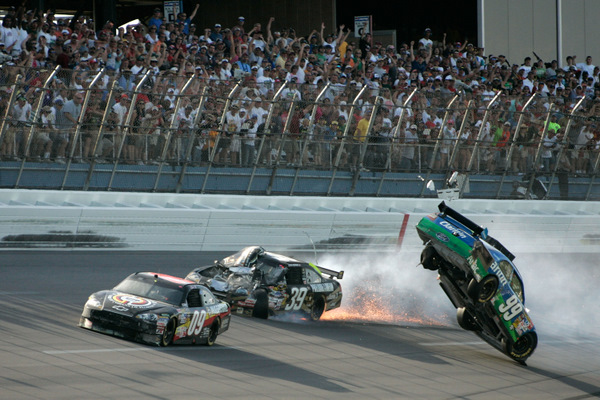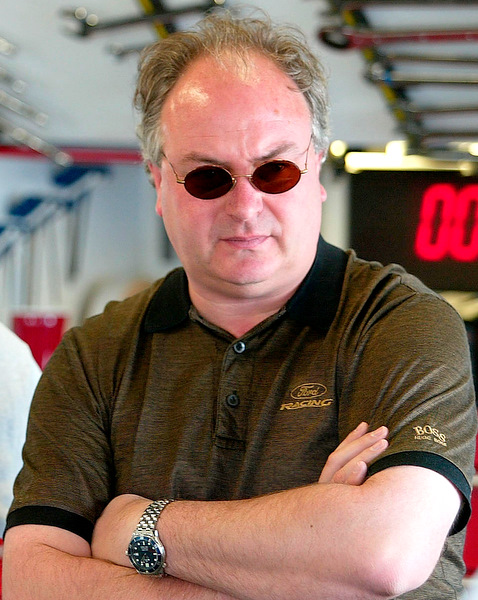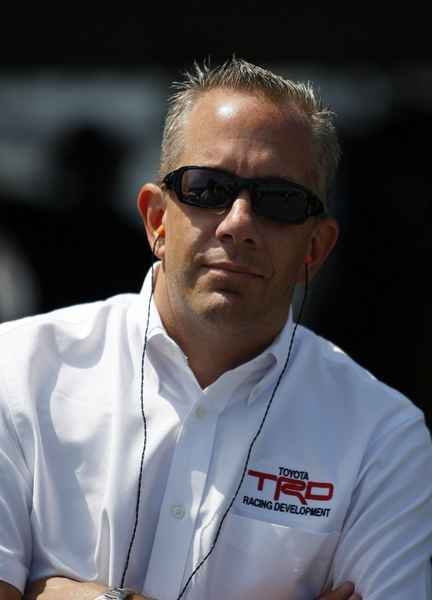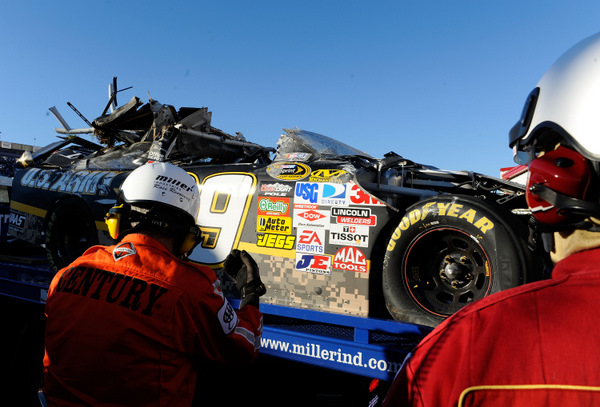So just how far have NASCAR safety specialists and Detroit engineers gotten in keeping these stock cars from flying...like Keselowski at Atlanta, like Newman and Edwards at Talladega?

Carl Edwards' flip at Talladega in April 2009 (Photo: Getty Images for NASCAR)
By Mike Mulhern
mikemulhern.net
BRISTOL, Tenn.
It is the other part of the Brad Keselowski-Carl Edwards Atlanta equation: how to keep these NASCAR stockers from flying through the air.
However when stock car teams hit Charlotte Motor Speedway Tuesday and Wednesday to test the new 'old' flat-blade rear spoiler, one big aerodynamic issue will apparently not be on the table there – how to prevent these race cars from flying, as Keselowski did at Atlanta two weeks ago.
NASCAR is working on various projects concerning that issue, but NASCAR safety director Tom Gideon, the long-time General Motors safety guru, and NASCAR's own engineers haven't yet made any formal presentation on any of those
"There is no evidence that suggests going from a wing to a spoiler will stop cars from getting airborne," Ford aerodynamicist Bernie Marcus said Sunday during an hour-long meet-the-press, on various aero issues in advance of the Charlotte test.
Marcus, who has been key in the development of Ford's new NASCAR Nationwide Mustang (set to debut at Daytona in July), has been a major aerodynamic figure in this sport since moving here from Formula 1.
The new flat rear spoiler, perhaps in part a response to fans' generally negative reaction to the wing (used on the car-of-tomorrow since its debut in 2007), is perhaps in part an engineering reaction to the flying cars at Talladega last year. There has been the sense by some drivers that the wing itself might have actually contributed to cars flying when turned backwards, by generating some lift, though Marcus insists "it is very, very low," particularly in relation to the 'parachute' aspect of a sudden massive flood of air under the rear of the car.

Ford's Bernie Marcus (Photo: Autostock)
But now a review of the Keselowski flip-and-fly at Atlanta appears to show that the wing might have played a role that crash too, perhaps altering the air flow to the roof flaps.
Where the real story here might be is not clear.
Here http://bit.ly/d5cK8 is video of the Talladega incident last April.
Here http://bit.ly/bpcZqu is video of the Atlanta incident two weeks ago.
And here http://bit.ly/3VRcTd is video of Ryan Newman's crash at Talladega last fall.
NASCAR president Mike Helton pointed to the flying car issue as the most important aspect of the Atlanta crash.
And there is debate over just why Keselowski's car became airborne, as well as debate over how to fix the problem, if it is fixable.
Marcus pointed to some damage to the rear deck area of Keselowski's car as "opening a gap of about three inches" that could have let a lot of air rush in. "I think that's the major reason the car lifted off in that particular way," Marcus said.
The Charlotte test will concentrate more on having drivers get used to the new spoiler and its' dirtier' air for the trailing car than in trying to find ways to prevent another "Keselowski" incident.
Toyota's Andy Graves, who has been working on these aerodynamics issues too, along with NASCAR's own engineer Daniel Honeycutt, says one key is to try to find ways to change the race car to increase the speed it requires to become airborne.
"When these cars get turned backwards, you lose a bunch of rear downforce, and the front gets pinned to the ground, which traps a lot of air under the car and lifts it up," Graves said. "That is one issue NASCAR is working on...to help increase the lift-off point – the speed at which it becomes airborne.
"With the current configuration, at 150 degrees – with the car turned around almost backwards – the lift-off point is close to 140 mph.
"But we have seen some cases where, in certain configurations, including removing the side-skirt (on the lower part of the body, on the left-side), we can push the number up to almost 180 mph.....in the mid-170s for sure. That (removing the lower side skirt) would be fairly simple, if they (NASCAR) decide to go that way.
"We've seen that putting the decklid 'fin' on, and a little taller fin on the rear window, definitely gets you halfway there – almost 20 mph (to a 160 mph lift-off point).
"The manufacturers are all working with NASCAR on various ideas, in an on-going testing process to make the cars safer.
"But when you look at just adding the fin and removing the left-side skirt and gaining almost 40 mph in the lift-off point, you can't ignore that. That's pretty significant."
However Graves pointed out that removing that skirt would lower the car's overall downforce and thus be a competitive disadvantage unless it were mandated across the board.
And Marcus added that removing the left-side skirt would only help in one type of spin.
"I don't think removing the right-side skirt would be much of an option myself, but the left-side skirt would definitely help," Graves said.
"There has been talk about designing some kind of flap in the rear that, if you got turned around, would dump that air from under the car. Some of the problems concern the rate at which the car spins, not just the angle it's at. And then it becomes more complicated."
Marcus: "Removing the left-side skirt is an option, in evacuating the air....but if you get a spin that goes clockwise, that could be disastrous because it would put even more air under the car, and it would take off like a jet."
One side issue, or perhaps not a side issue at all, is NASCAR's 'mandate' for three different aerodynamic goals for its three national touring series, Truck, Nationwide and Cup: The Trucks are designed to have the highest downforce; Nationwide cars are designed to have about 20 percent less downforce; and Cup cars are designed to have about 40 percent less downforce. That is because NASCAR wants the Cup car to be the most difficult to drive.
However drivers – in every racing series – always want more downforce. Downforce makes drivers more comfortable and thus more willing to race each other hard. And that could well be born out in NASCAR, where the Truck tour is generally conceded to have the best racing, the Nationwide the next best racing, and the Cup tour third.
But the rear spoiler change in the Cup cars, along with some other aerodynamic changes, are expected to give more downforce: Marcus says he anticipates the Cup cars to go from 40 percent less downforce than Trucks to about 32 percent less downforce.
And the changes should make the Cup cars turn better too.
NASCAR isn't the only racing series in the world, but Marcus pointed to the sheer number of high-speed ovals in this branch of the sport as a major factor in flying cars, where Indy-car, Formula 1 and others typically run more road courses, "so you don't see these types of high-speed accidents very often.
Sunday's Bristol 500 was the last race for the rear wing...exactly three years after its debut. Stock car teams are going back to the old flat-blade spoiler; will it make for safer racing? Tuesday's big test at Charlotte should tell us all something. (Photo: Getty Images for NASCAR)
Of course with all the engineers in this sport, it might time to open the chapter of the college physics textbook that points out "L = Cl x (p x v2)/2 x A."
In other words, lift is related to velocity squared.....
Which means, in layman's terms, that if NASCAR would slow the cars down a little, the risk of lift-off could be reduced substantially.
At Atlanta, for example, speeds were up considerably, because of new Goodyears, some six mph faster this race than last year, with Dale Earnhardt Jr. posting the quickest qualifying speed ever for a car-of-tomorrow. Perhaps that extra speed was a factor in the Keselowski crash....
Robert Yates began pointing out that NASCAR stockers were going too fast back in 1993. However the battle for more horsepower and faster cars has continued unabated, to where drivers now have nearly 900 horsepower at their foot. And NASCAR has showed no interest in slowing these race cars.
Whether, or when, speed might be put on the table for aerodynamic consideration by NASCAR is unclear.
"The faster the race track, the more inclined you are to have bigger accidents. You don't see cars flying through the air at Martinsville," Marcus said.
So if Keselowski's car had been running five or six mph slower he might not have gotten airborne?
No answer here yet.

Toyota's Andy Graves (Photo: Toyota Motorsports)
And tucked in here somewhere is the not-so-inconsequential issue of Detroit car makers wanting their NASCAR race cars to look more like street-production cars, to have more brand identity.
Currently NASCAR stockers are all virtually identical, based on common template designs, with little in common visually with the street version.
The new Nationwide car is to have more brand identity than the current Nationwide car. When that trend will lead to changes in Cup car design is not certain, but there is behind-the-scenes debate between NASCAR and the car makers on that issue.
And just how many cars does Detroit sell with a flat-blade rear spoiler and 'shark-fin' rails on the rear deck, like NASCAR will test Tuesday at Charlotte?
"But there is a safety factor here," Marcus replies. "Not many cars on the freeway running 70 mph spin out like race cars do at Talladega and Michigan."
If Brad Keselowski had this new aero package at Atlanta, would it have made a difference?
"Maybe, maybe," Marcus says cautiously.
"We have been working with NASCAR over the years on lift-off testing, to help keep the cars on the ground.
"But every accident is different, every spin is different, and it is very difficult to simulate an accident."
[Note: You can use Twitter as an easy headline service for mikemulhern.net stories, with our instant Tweets to your mobile as soon as our newest NASCAR story is filed. And mikemulhern.net is mobile-friendly for viewing. You can also use the orange RSS feed button as a quickie headline service on your laptop or home computer for mikemulhern.net stories, by creating a Live Bookmark RSS feed on your web browser's toolbar. Or you can create a Google Alert for mikemulhernnet.]

Ryan Newman's luck at Talladega hasn't been that great lately.....(Photo: Getty Images for NASCAR)
© 2010-2011 www.mikemulhern.net All rights reserved.
Web site by www.webdesigncarolinas.com







re. Butts in the Seats:
re. Butts in the Seats: Watching the Bristol Sprint Cup race, performed before what looked like a head count Bristol should have Friday at 10am, and seeing the acres of empty grandstands at Atlanta last week makes me wonder what has happened. Is it merely the economy, or it is the (former?) NASCAR fan base saying "Your cookie-cutter drivers and cars are boring us"? I was hoping to see a race this afternoon (between my toes on the couch, I should add) but my eyes closed around lap 50 and didn't open until 25 laps to go. Why? 'Cause y'all are puttin' on a show that bites. NObody's putting on real racing these days. The 12 Hours of Sebring race on Saturday was a snoozer, as was Formula 1 a week ago from that other planet in the Middle East desert. Bring back David Pearson. Bring back Rusty vs. DW. Let me see the difference between a Ford and a Chevrolet.
Can I have an "Amen?"
Amen, my bro, amen. too many
Amen, my bro, amen. too many drivers making too much money and complaining way too much. but now i must say the racing this year has been better, and bristol was some good stuff....me, i miss dale earnhardt....rattle their cage....and i agree heartedly about show me the difference between a ford and chevy and dodge and toyota.....detroit has gotten too lazy about this....and i was surprised the crowd wasn't better....but $200 a night hotel rooms will make anyone, particularly mikemulhern.net, think twice...fans are still interested but they're tired of the gouge.....IMHO....of course i have to give it to these guys, someone at least is trying to generate interest, with all the controversy and hoopla....but is it too little too late? why wasnt anyone listening the last two years about this cot.....woof!
"Nobody's putting on real
"Nobody's putting on real racing these days." Now I'm no fan of what Bristol usually puts on for racing, but this particular Southeastern 500 was much better than what we've seen here since 1991; this was the first time I can remember since then that we had an actual battle for the lead worthy of the name, and the first time I can recall where they could actually race at Bristol clean. I wasn't sold on the progressive banking idea because it was overrated at Tuscon (the first track I can recall to use it) and it hasn't worked at Homestead, but here at least we finally saw some actual nose-to-nose racing up front.
What's happened is the lack of lead changes in these races has driven fans away. The "let me see the difference between a Ford and a Chevrolet" argument has no credibility anymore because form following function dictated the cars "be alike." This race was the first good one at Bristol in nearly twenty years and is the kind of racing that people should want to see - hard racing without rubbing; lead changes; nose-to-nose for sustained periods. If people say they want to see rubbing, they're watching racing for the wrong reasons.
And Rusty vs. DW got tiresome almost as soon as it started.
Why is no one looking at the
Why is no one looking at the obvious angle? These cars are running 20-plus MPH faster than what a track like Atlanta can handle, and even with present restriction the cars routinely flirt with 200 in the draft and it has been known for over ten years (Rusty Wallace for one has noted this) that 194 is the cut-off point for keeping them on the ground (my own view is this is too high an estimate; 190 should be called the cut-off point).
What everyone continues to look at is the wrong thing - the right thing is the cars must not be allowed to break 170 on a banked intermediate superspeedway like Atlanta and must not be able to reach 194 at Talladega, draft or no draft.
That this isn't foolproof is obvious, but it works better than what they've done so far in not attacking the speed of the cars.
certainly....and you of all
certainly....and you of all people stp43 understand all the nuances....these cars are too flipping fast. period. slow 'em down, like robert yates pleaded back in 1993...BEFORE ernie's crash....900 hp? give me a break. cut 300 horsepower out of these things across the board.....
Reply to comment
I agree these cars have way
I agree these cars have way too much power and have been saying that for years. Mike, you are the only writer who consistently voices this message and too bad no one in Daytona is listening. The racing would be a million times better with 600HP vs the 900+ they have now. NASCAR should have used Toyota's entrance into the sport to totally redesign the engine specs in this series instead of a new car. As for the cars flipping, I think it is a complicated matter. The old cars were MUCH better at staying on the ground when they turned backwards. They would turn, the flaps would open and boom they were back on the ground for the most part. Maybe putting the spoiler back on will make a difference, but that remains to be seen. My guess is Talladega will likely have somewhat of an answer when someone is spun around.